At the start of the First World War on 4 August 1914
Germany invaded Belgium. From that moment onwards hundreds of thousands of Belgians fled
to the Netherlands; among which were about 40.000
Belgian military refugees. In conformity with the
Peace treaty of The Hague of 18 October 1907 the neutral nation of the Netherlands was
obliged to disarm and intern EVERY military man.
In the first days of war 52 Belgian and
179 German military men had crossed border with Limburg and they were interned
(together!)
in Alkmaar where the empty barracks was appointed internment camp by the
government. The
Belgians were soon after transferred to Camp Gaasterland.
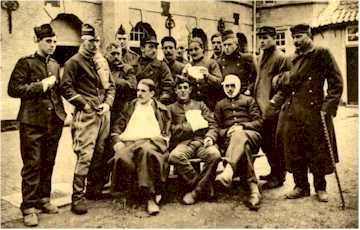 |
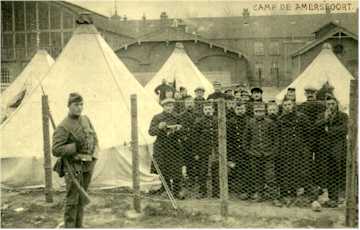 |
| Wounded Belgians at Middelburg 1914 |
Camp of tents at Amersfoort at the
end of 1914 |
On 10 October 1914 the fortified city of Antwerp
fell. Next to an estimated 1,000,000
civilian refugees over 40,000 military refugees fled to the neutral Netherlands to escape
the possibility of becoming prisoners of war. Because of the chaotic situation
approximately 7,000 soldiers dressed in civilian clothes were able to escape via
Vlissingen to England and enrol again for military services there. Over 33,000 military
men were disarmed. Among these were 6 generals and 400 other officers (these officers were
all interned at Zwolle).
Next to these Belgians 1,600 English military men of the First
Royal Naval Brigade had fled to the Netherlands. They had landed at Zeebrugge and were
employed at the defence of Antwerp. This English military was given the order to
co-operate with part of the Belgian army in delaying the advance of the German army in the
North. In doing so retreating had become impossible.
The military refugees who had fled to the Netherlands were transferred to empty
(because of the mobilisation) barracks in the Netherlands:
- Amersfoort (near which
Camp Zeist was built)
- Harderwijk (this is where
Camp Harderwijk developed)
- Groningen (here the English
Camp (het Engelse Kamp) was set
up)
- Oldebroek (Camp Oldebroek
was closed down in July 1916)
- Alkmaar (Camp Bergen was
built for the German military refugees.
The Belgian military refugees
who were originally also interned in Alkmaar
were transferred to Camp Gaasterland,
which was
closed down in December 1916).
Refugees were accommodated in the barracks of:
- Leeuwarden (1,200 people)
- Assen (2,500 people)
- Kampen (1,800 people)
- Zwolle (400 people)
- Loosduinen:
‘Ockenburgh’estate (1,500 people).
These camps were all closed down at the start of 1915.
The English military refugees were first transferred to the barracks at Leeuwarden and
Groningen. The Leeuwarden-group was transferred after a couple of weeks to Groningen where
from 1 December to 3 January a camp of barracks was built (the English Camp) that due to
the terrible weather conditions was only put into use on 18 January 1915.
Before the fall of Antwerp on 10 October there were already 2,200 interned Belgians
accommodated at Gaasterland, spread over the different villages: Oudemirdum, Rijs,
Bakhuizen, Balk and Sondel. Security (450 men) was difficult to obtain because of its
size.
Amersfoort and Harderwijk had to accommodate the greater part of these
interned. At first this took place in existing barracks that turned out to be much too
small. At Harderwijk (there were 13,000 military refugees to
accommodate) a camp of tents
was erected 2 kilometres from the centre. At Amersfoort 15,000 people had to find shelter
in a barracks designed for only 4,000. Here a camp of 900 tents was erected. The crowded
barracks of Amersfoort forced Bosboom (the then Secretary of State for War) to build two
wooden camps of barracks (Camp I and II) as early as mid-October 1914 near Zeist on the
estate of the local government of Soesterberg. The official name of this camp was:
Internment camp Amersfoort - near Zeist: usually referred to as Camp Zeist. The camp
existed of two camps of 24 barracks in an area of 25 hectares separated by a broad aisle
fenced in with barbed wire. Later sports grounds were laid out here. 12,000 to 15.000
interned could be accommodated here.
In December 1914 at Harderwijk the building of a camp of barracks was begun in the area
where the (provisional) camp of tents was erected. In an area of 32 hectares there were 50
barracks built where a further12,000 to 15,000 interned could be
accommodated. The camps
Zeist and Harderwijk were designed as small villages: with schools, shops,
bathhouses, canteens, churches, post offices, etc.
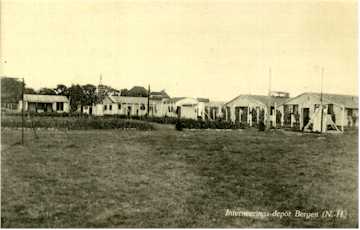 |
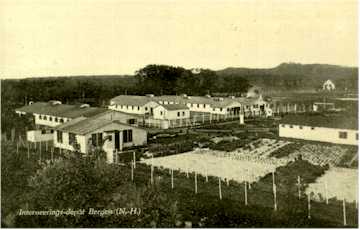 |
| Camp Bergen (NH) for interned Germans |
Panoramic view of Camp Bergen
(NH) |
German officers and men were firstly interned in the barracks of Alkmaar. Later they
were transferred to the near, newly built, internment depot of Bergen (NH). On 1 January
1915 there were three German officers and 122 men in the camp. Among these were a large
number of deserters and this caused a lot of problems and fights. In May 1916 after
thorough investigation 32 deserters were released. In 1917 the number of deserters
escaping to the Netherlands increased. That is why a specific camp for deserters was
established next to the original camp. In 1917 after the required research 554 deserters
were released.
The increase in the number of interned was mainly caused by the internment of stranded
aircraft crew, marine ships and submarines. Belgian, British and French officers who
refused to give their word not to flee were interned in the fort Wierickerschans near
Bodegraven and on the island of Urk. From March 1915 in the former Depot of Discipline at
Vlissingen a penal settlement was erected to isolate ‘undisciplined
individuals’.
Interned who were married had special rights: their families were allowed to settle
near the camps and the married interned were given permission to visit
regularly. This
resulted in a housing shortage and therefore complaints of increasing rents. Because of
the failing economy more and more wives were without income which made internment an ever
present threat.
To solve this problem seven family villages or women’s villages were built:
near Amersfoort:
-
Alberts’ Dorp (Dorp meaning village)
- Elizabeths’ Dorp
- Nieuwdorp
near Harderwijk:
-
Leopolds’ Dorp
- Heidekamp
near Gaasterland:
- Boschkant
near Oldebroek:
- Moensdorp
In May 1918 6,640 families had settled in these villages.
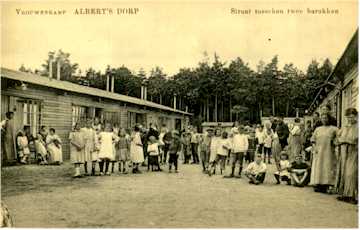 |
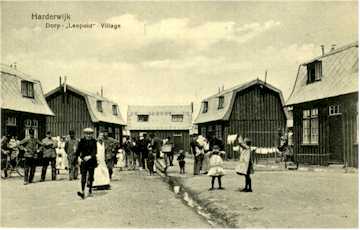 |
| Women’s Camp Alberts’ Dorp near Amersfoort |
Women’s Camp Leopolds’ Dorp near Harderwijk |
Because of employment
in Dutch companies more and more interned left the camps.
They were accommodated in the Depot of Internment groups
(Depot der Interneringsgroepen). They worked in the
so-called internment groups or internment depots that were
under supervision of a Dutch officer, erected near the place
of employment. Work could be found for example in the mines
of South Limburg and at the port of Rotterdam.
This employment was always discussed with the Central
Employment agency (Centrale Arbeidsbeurs). Interned were
only hired when there were no Dutch employees available.
However, there was a great shortage of labourers, because a
large number of Dutch young men was mobilised. When
researched it appeared that on 1 September 1918 from the
31,256 interned 11,432 were employed in groups or depots and
3,012 were employed individually - this is 46,2 % of the
total. The internment camps slowly depopulated. Therefore a
few reorganisations were made. From mid-1917 only four camps
remained in use: Zeist, Harderwijk, Groningen and Bergen
(NH).
Following Oldebroek and Gaasterland (closed down
respectively in July and December 1916) Camp Harderwijk
threatened to close down at the start of 1918. The remaining
interned would have to be transferred to Camp Zeist.
However, thanks to intensive lobbying of especially the
shopkeepers of Harderwijk, on 2 September 1918 the remaining
4,500 inhabitants of Camp Zeist were very unexpectedly
transferred to Camp Harderwijk.
In the Netherlands
there has been a total of the following interned: 33,105
Belgians (among which 406 officers), 1751 British (139
officers), 1461 Germans (68 officers), 8 French (5 officers)
and 4 American officers. The interned from France and
America came from aircraft that landed on Dutch soil.
On 11 November 1918
the war was ended. However, it took until the signing of the
peace treaty before the Dutch government started discussing
the repatriation. Only starting December 1918 could the
interned return to their homeland.
Literature: Literature
on internment and refugees
|